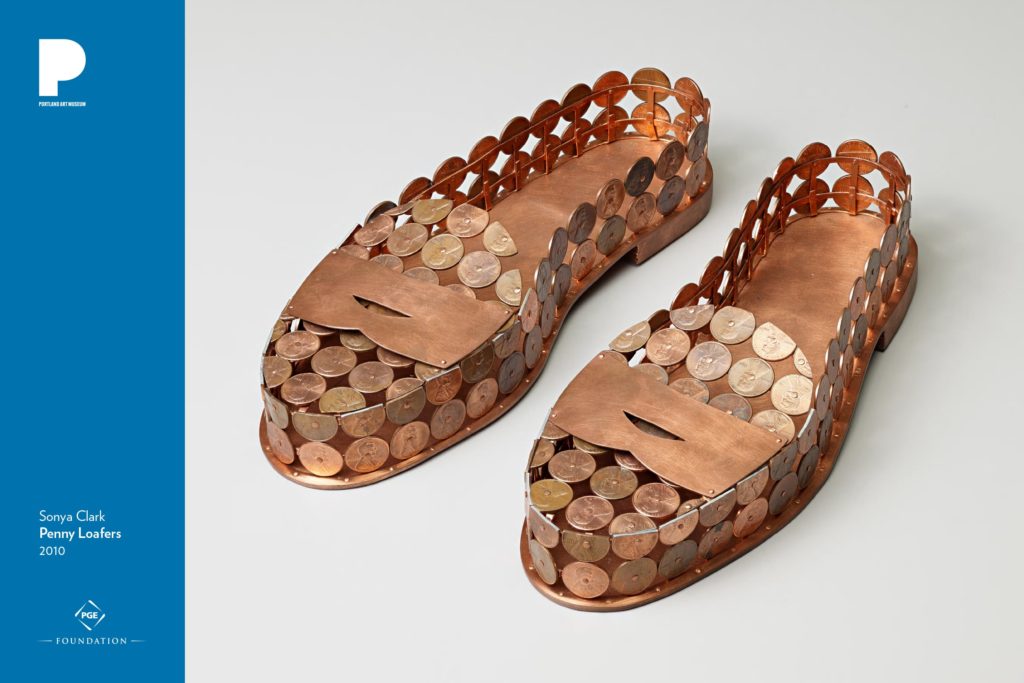
Sonya Clark works at the intersection of craft and conceptual art. She is a contemporary, African American, multimedia artist who frequently incorporates human hair, sugar, beads, and ready-made objects, such as currency, flags, and combs, into her work. Through these materials, along with occasional performance elements, Clark explores themes such as the history of craft (weaving, embroidery, beading), racial inequality, and the narrative nature of ancestry and culture. The artist explains how, growing up in Washington, D.C., the child of a psychiatrist from Trinidad and a nurse from Jamaica, “I gained an appreciation for craft and the value of the handmade primarily from my maternal grandmother who was a professional tailor. Many of my family members taught me the value of a well-told story and so it is that I value the stories held in objects.”
Clark intentionally uses ready-made objects as a way to explore the stories that objects tell. She explains that “Objects have personal and cultural meaning because they absorb our stories and reflect our humanity back to us. Sometimes common objects are sponges. Sometimes they are mirrors. I am instinctively drawn to objects that connect to my personal narrative as a point of departure: a comb, a piece of cloth, a penny, or hair. I wonder how each comes to have meaning collectively.”
The sculpture Penny Loafers is one of several of Clark’s works that explore the portraits and symbols found on currency with a sense of humor and irony. (See also Afro Abe an embellished five-dollar bill included in the 2017 exhibition Constructing Identity.) In Penny Loafers, Clark replaces the leather upper of the shoes with pennies lined side by side in rows over thin copper frames. The round shapes of the pennies create negative spaces, allowing viewers to peer through the sides and top of the shoes. The pennies making up the vamp or tongue of the shoe are cleanly cut to form a graceful arc. Both the sole and the saddle (the decorative piece over the top) are solid copper and contrast with the airy spaces formed by the rows of pennies.
Clark asks us to think about the way a culture communicates its values in the representations found on coins and paper money. These works translate and transform the official likeness of Abraham Lincoln, the U.S. president who issued the Emancipation Proclamation, declaring the end of slavery in the Confederate States, in 1863. Choosing hundreds of pennies to create a set of heavy shoes, Clark suggests that Lincoln’s weighty legacy is both fraught and celebrated. However, the nearly valueless penny—or light weight of today’s alloyed coins—asks whether we truly appreciate the complexity of this pivotal and transformational figure in American history.
Clark considers the natural oxidation of the copper pennies to be an integral element of the work; tarnish manifests the hanging nature of the material over time. Tarnish also suggests the ongoing shifts in our own memories and understanding of both familiar objects and historical figures. Finally, the pennies allude to historical narratives that are larger than the United States by evoking the cowrie shell, one of the earliest beads included in textiles and one of the oldest forms of currency, used widely across Africa, Asia, and Oceania for centuries.
By creating art from readymade objects like the penny, Clark layers her work with cultural, historical, and personal narratives in all their complexity and contradiction.
Artist quotes from brochure for Converge, an exhibition that features the art work of Sonya Clark and Quisqueya Henriquez on view at McColl Center for Visual Art from January 27 to March 24, 2012.
Discussion and activities
- Imagine placing your feet inside Sonya Clark’s Penny Loafers. How would they feel to wear?
- Write down three examples—from popular culture today or in the past—of shoes that carried special significance. What makes the shoes meaningful? What are their wearers trying to communicate?
- Think about your own shoes. How do they communicate your identity? Draw a picture of your favorite pair of shoes—real or imagined.
- Create a sculpture of an everyday object using unexpected or unfamiliar materials. How does the process make you think differently about the object and about art?
- Write Around PAM: Sonya Clark. A writing prompt inspired by Penny Loafers and developed by museum partner Write Around Portland.
Recommended resources
- Healing Justice & Revolution of Values
- Sonya Clark
- Interrogating the Past: Sonya Clark Interviewed by Scott Turri, BOMB Magazine, July 4, 2019.
- Measure your history with material. | Sonya Clark | The Art Assignment April 28, 2016
- Converge. Charlotte, NC: McColl Center for Visual Art, 2012.